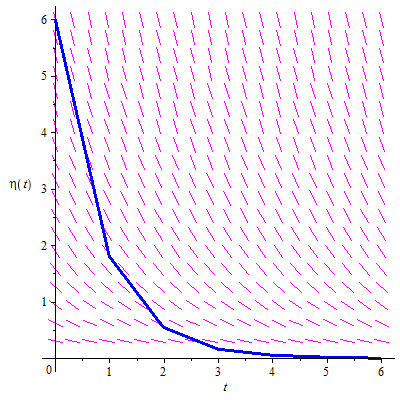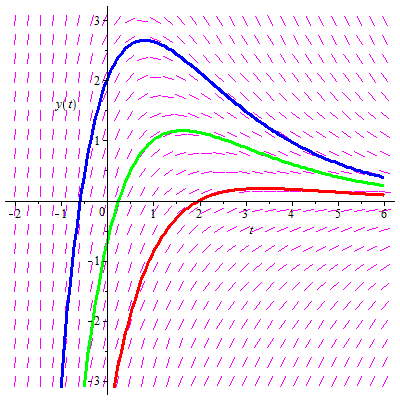Differential equations: Direction field
 Euler's method
Euler's method
If an explicit first-order dynamic system has no exact solution (in terms of known functions), or if a first orientation of the behavior of the system is desired, the geometric approach with the direction comes into the picture. By following the line elements of the direction field, we find an approximation of the solution curve with given initial condition by means of line segments.
Euler's method
Consider the dynamic system of the form \[\frac{\dd y}{\dd t}=\varphi(t,y)\] where #\varphi# is a continuous function of two variables.
Let #\delta# be a small positive number. A numerical approach to the solution curve of the dynamic system with initial condition #y(t_0)=\eta_0# is given by the iterative formula \[ \eta_{k+1}=\eta_k+\varphi(t_k,\eta_k)\cdot \delta\] where the points \(t_k\) are chosen so each pair of subsequent points is at distance \(\delta\), so \[t_k=t_0+k\cdot \delta \] for \(k=0,1,2,\ldots,n\).
This approach is called Euler's method and the number \(\delta\) is called the step size.
We begin with \(\eta_0=y_0\) at time \(t_0\) and determine the approximation \(\eta_1\) of \(y(t_1)\) by using the tangent at the point \(\rv{t_0,\eta_0}\) as an approximation to the graph of the solution \(y\) the segment \([t_0,t_1]\): \[ \eta_1=\eta_0+\varphi(t_0,\eta_0)\cdot \delta \] Starting with the known point \(\rv{t_1,\eta_1}\) we approximate the next function value \(y(t_2)\) by \[ \eta_2=\eta_1+\varphi(t_1,\eta_1)\cdot \delta\] And so on. This approximation process leads to the general formula for \(\eta_{k+1}\).
Numerous algorithms for the numerical solution of differential equations exist; these are beyond the scope of this course. The most important message is that there are such numerical solution methods and these are useful for gaining insight into solutions of the ODE.
Enlarge the number #s# of steps in order to see a version with smaller step size, and enter different right hand sides of the differential equation in the input field behind "#\dd y/\dd t =#". Press the update button to see the result.

Or visit omptest.org if jou are taking an OMPT exam.





